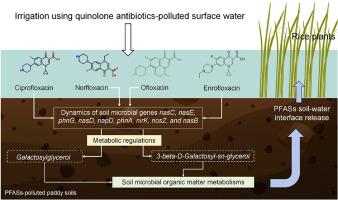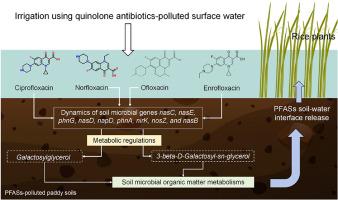Irrigation-introduced quinolone antibiotics activated the soil-water interface redistribution of per- and polyfluoroalkyl substances in paddy fields
IF 7.3
2区 环境科学与生态学
Q1 ENVIRONMENTAL SCIENCES
引用次数: 0
Abstract
Quinolone antibiotic pollution (QAP) introduced by irrigation may cause the release of per- and polyfluoroalkyl substances (PFASs) at the soil-water interface in paddy fields, endangering the growth of rice crops and the security of human food sources. Thus, the comprehensive investigation of the joint and individual effects of quinolone antibiotics with environment-relevant concentrations on the soil PFASs migration were conducted. Results showed that the QAP dose of 1 μg/L had the highest activation for the release of PFASs into the overlying water, resulting in the highest net concentration of 99.32 μg/L. Structural equation modeling revealed that the QAP-mediated microbial adsorption was the hub transition for PFASs migration (p < 0.001). The PFASs re-partitioning after QAP was primarily driven by physicochemistry and nutrient cycling variations induced by QAP, which was facilitated by soil microbial urease and acid phosphatase. The soil microbial genes nasC, nasE, phnG, nasD, napD, phnA, nirK, nosZ, and nasB were identified as the critical regulators of PFASs migration under QAP by the aggregate boosted tree modeling. Molecularly, the soil microbial metabolisms of Galactosylglycerol and 3-beta-D-Galactosyl-sn-glycerol were responsible for PFASs release under the QAP level of 1 μg/L (p < 0.001). These findings were beneficial in elucidating the ecological risks of bioavailable PFASs in paddy fields subjected to the integrated pollution of quinolone antibiotics.


灌溉引入喹诺酮类抗生素对水田单氟烷基和多氟烷基物质土壤-水界面再分配的影响
灌溉引入的喹诺酮类抗生素污染(QAP)可能导致稻田土壤-水界面释放全氟烷基和多氟烷基物质(PFASs),危及水稻作物的生长和人类食物来源的安全。因此,全面研究了喹诺酮类抗生素与环境相关浓度对土壤PFASs迁移的联合效应和个体效应。结果表明,QAP剂量为1 μg/L时,对PFASs向上覆水体释放的激活作用最强,净浓度最高,为99.32 μg/L。结构方程模型显示,qap介导的微生物吸附是PFASs迁移的枢纽过渡(p < 0.001)。土壤微生物脲酶和酸性磷酸酶促进了QAP诱导的土壤理化和养分循环变化。通过聚合增强树模型确定土壤微生物基因nasC、nasE、phnG、nasD、napD、phnA、nirK、nosZ和nasB是QAP条件下PFASs迁移的关键调控因子。在1 μg/L QAP水平下,半乳糖甘油和3- β - d -半乳糖-sn-甘油的土壤微生物代谢与PFASs释放有关(p < 0.001)。这些发现有助于阐明喹诺酮类抗生素综合污染下水田中生物可利用性全氟辛烷磺酸的生态风险。
本文章由计算机程序翻译,如有差异,请以英文原文为准。
求助全文
约1分钟内获得全文
求助全文
来源期刊

Environmental Pollution
环境科学-环境科学
CiteScore
16.00
自引率
6.70%
发文量
2082
审稿时长
2.9 months
期刊介绍:
Environmental Pollution is an international peer-reviewed journal that publishes high-quality research papers and review articles covering all aspects of environmental pollution and its impacts on ecosystems and human health.
Subject areas include, but are not limited to:
• Sources and occurrences of pollutants that are clearly defined and measured in environmental compartments, food and food-related items, and human bodies;
• Interlinks between contaminant exposure and biological, ecological, and human health effects, including those of climate change;
• Contaminants of emerging concerns (including but not limited to antibiotic resistant microorganisms or genes, microplastics/nanoplastics, electronic wastes, light, and noise) and/or their biological, ecological, or human health effects;
• Laboratory and field studies on the remediation/mitigation of environmental pollution via new techniques and with clear links to biological, ecological, or human health effects;
• Modeling of pollution processes, patterns, or trends that is of clear environmental and/or human health interest;
• New techniques that measure and examine environmental occurrences, transport, behavior, and effects of pollutants within the environment or the laboratory, provided that they can be clearly used to address problems within regional or global environmental compartments.
 求助内容:
求助内容: 应助结果提醒方式:
应助结果提醒方式:


